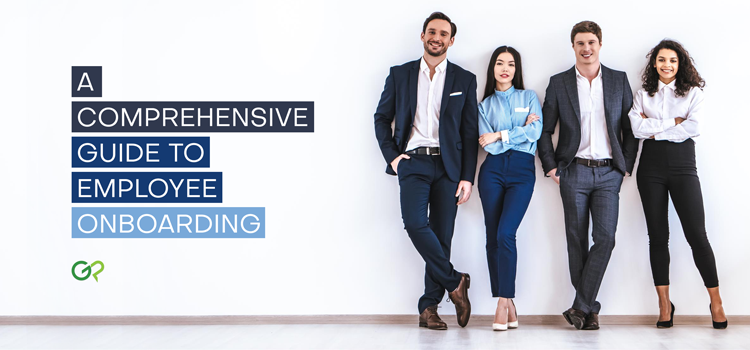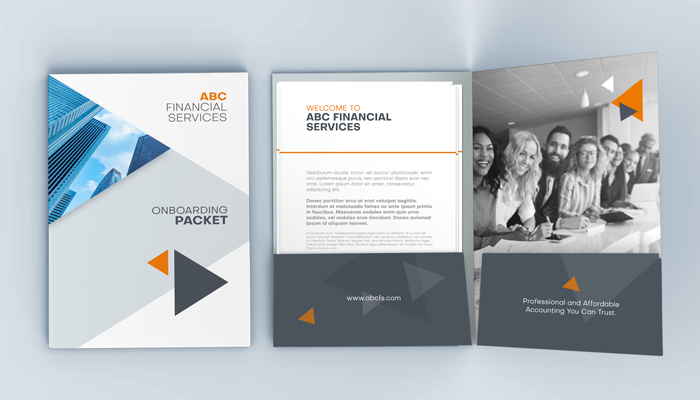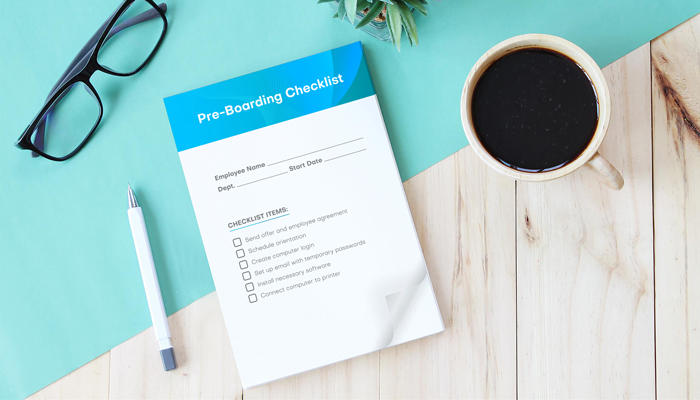As a business owner, you probably have a business plan and a marketing plan, but do you have a formal onboarding plan? If not, it’s never too late (or too early, if you have yet to hire your first employee) to put one in place. After all, once you’ve found an amazing and talented employee, it’s usually in your best interest to retain him or her. A structured onboarding program sets the foundation for a mutually beneficial employment relationship and builds your employees up for continued success within your company.
What Exactly is Onboarding?
First, a quick overview of onboarding, in case you’re not familiar with the term. Onboarding is the series of steps you take to fully integrate a new employee into the company and the job. It encompasses everything from the initial paperwork to formal training to goal setting. Your objective is to give a new employee the knowledge and tools he or she needs to become a fully productive and successful team member – keep in mind that this can take anywhere from a few months to a year (or more).
As an employer, you have a lot to gain from developing and sticking to a carefully crafted onboarding plan. Your employees will be more focused and goal-driven, and as multiple studies have shown, more likely to stay with your company for at least 3 years versus employees that do not undergo any onboarding whatsoever.
The Interview
Although onboarding technically begins once an employee has been hired, the first interview is usually when candidates are forming their initial impressions and mentally taking notes about whether or not they’d like to work for your company.
If your company website has a careers page, many job applicants are likely to check it out prior to coming in for an interview. In addition to making sure the page is continually updated with open positions, consider adding executive profiles, descriptions of the various departments, work environment photos, and essential information about the interviewing process (address, where to park, what they need to bring).
It’s important to make sure all common areas are neat and organized, of course, but don’t shy away from giving a glimpse into your company’s culture. Everything from the furniture in the lobby to the art on the walls should clue candidates into whether the general culture is more conservative or free-spirited.
Review each candidate’s resume prior to the interview and prepare must-ask questions in advance. As you wrap up the interview, hand the candidate your business card (so they can follow up via email) and give him or her an overview of what the next steps will be and a general idea of when you are planning to make your final decision.
The Employee Handbook
Other than the employment agreement, the company’s official employee handbook may be the most important document you’ll give a new employee. Although the layout and contents of employee manuals vary by company, they should address core policies and procedures, including safety requirements, benefits, time off, dress codes, mandated breaks, and so forth. The goal of the employee handbook is to clearly lay out what is expected in terms of attendance, performance, and conduct.
Since laws and regulations change regularly, plan on updating the employee handbook at least once a year. An in-depth manual can protect the employer as much as (if not more than) the employee should a dispute arise, so it’s better to be overly detailed and cautious than vague or incomplete.
Each employee should be given a print copy of the guide and asked to sign an acknowledgment form that they have received it. If your company has an internal wiki or online portal, upload a digital copy along with any other forms and resources they may need.
The Welcome Packet
In addition to the employee handbook, you may want to assemble some informal tips to help new hires settle in during the first few days.
This supplemental packet can include information such as:
- FAQ sheet – commonly asked questions about payroll, dress codes, holiday schedules (even if these are already addressed in the employee manual)
- A map of the building, with break rooms, restrooms, and other common areas clearly labeled
- Employee discount information
- A list of recommended restaurants and food trucks in the area
- Important dates such as product launches and scheduled company-wide events
Keep the contents neatly organized in company-branded custom folders for easier storage and presentation.
PreBoarding
You want a new hire’s first day to be as seamless as possible, so it’s important to establish a pre-boarding process that kicks off as soon as your offer is accepted. On the administrative side, email the employee the employment agreement to review in case they have any questions. Be sure to let them know if there is a dress code or any parking restrictions and what their orientation schedule will be. Provide a detailed list of items they need to bring on their first day (void check for direct deposit, identification, social security card).
This is the time to conduct a background check or schedule a drug screening and order any equipment, tools, and supplies they may need. If the new employees will be meeting with outside clients and vendors the first week, order their business cards as well.
Set up the employee’s workspace so they will be ready to go on their first day. In addition to the standard pens, notepads, and paper trays, your employee will appreciate a few thoughtful extras such as a cabinet to store personal items and a custom mug they can keep at their desk.
If possible, set up computers and email addresses in advance. For example, all of the following steps can be done before an employee’s first day:
- Create a login for their computer or laptop
- Set up an email address with a temporary password
- Insert your company’s standardized email signature
- Add email addresses to any department or company-wide email lists
- Install any necessary software
- Connect their computer to the nearest printer
- Provide a list of all the logins and passwords the employee will need
Finally, draw up a 30, 60, and 90-day plan outlining the goals you hope they will accomplish within those time frames. This will help you clearly define the new employee’s responsibilities and priorities.
Orientation
Each business should have a standardized orientation program that applies to everyone from interns to executives. This ensures that everyone is on the same page regarding the company’s values and policies. Although the exact steps will vary depending on the company size and industry, there are a few key elements that all companies should incorporate, such as:
- Personnel paperwork and documentation (tax forms, emergency contact, etc.)
- Overview of benefits (insurance, retirement plans, etc.)
- Workplace safety and compliance videos
- Signature acknowledgments of crucial policies and procedures (cell phone usage, vacation blackout dates, nondisclosure agreements)
If your company has a large building or campus, arrange for a friendly long-time employee to give a tour after the orientation. This will allow your employee to stretch his or her legs and gain valuable insight into the culture and history of the organization.
The First Day
The first day will naturally be nerve-racking, so it’s important to find the right balance that allows the new hire to feel productive but not overwhelmed. Have them start on low-stakes tasks such as configuring their computer or composing an email introducing themselves to the rest of the company.
Schedule a 1:1 meeting between the employee and his or her manager. The manager should discuss the expectations for the first few months, go over the 30, 60, and 90-day plan and address any questions about the role. Have a small project ready for them to jump into, ideally a project in which they are guaranteed to succeed. Not only will this help instill confidence in their abilities, it will give them an idea of the department’s workflow.
The First Week
If a new employee needs any training or shadow sessions, schedule them for the first week. For example, they may need to learn about your various products and services, machinery/equipment, and preferred software applications. Many companies also have their new employees (regardless of their roles) spend at least one day in customer service to get a feel for the types of questions and issues that arise.
If the employee will have any direct reports, he or she should meet with them one-on-one during the first week to get to know them better and gain a thorough understanding of their roles and responsibilities.
Toward the end of the first week, host a catered welcome lunch for the new hire’s team. This will help break the ice by giving everyone a chance to interact in a more relaxed setting. For smaller companies or senior hires, you may prefer to take the new employees out to lunch instead. Ask them about their first impressions of the company and any early concerns or suggestions they have. Don’t forget to get their feedback on the onboarding experience and whether anything can be improved.
The First Month
By the end of the first month, you should have a better grasp of a new employee’s strengths and weaknesses. If your company conducts formal performance reviews, schedule a 1-month appraisal so they understand what metrics are used to evaluate their performance. Highlight the areas in which they excel and provide constructive feedback as well.
This is a good time to compare their progress to the company’s expectations. Are they on track to meet deadlines? Has the department’s overall productivity increased? This should be a two-way conversation, so ask for the employee’s perception of the position and if there are any additional tools or resources they need to succeed.
After Three Months
After three months, employees should be demonstrating increased confidence and ownership of their responsibilities. Schedule a check-in meeting at this point to discuss the following:
- What do they hope to accomplish in the next 12 months? Ask them to put together a plan or roadmap with specific goals.
- What obstacles are they facing and what do they need to help overcome them?
- How is the role fitting in with their professional goals? What would they like to see in terms of career development within the company?
Transitioning to an unfamiliar company can be difficult, but a welcoming onboarding program will help alleviate the new employee’s concerns and speed up the adjustment process. By establishing, revisiting, and evolving the onboarding process on a regular basis, you can reduce turnover, increase efficiency, and foster a more comfortable and safer work environment!


